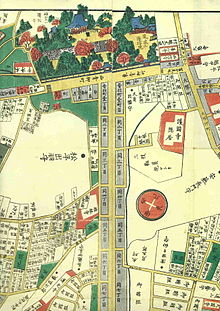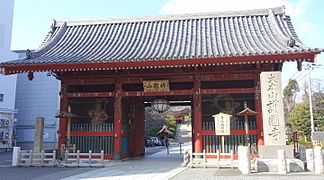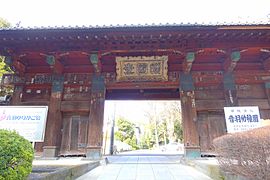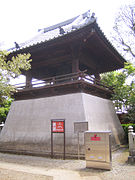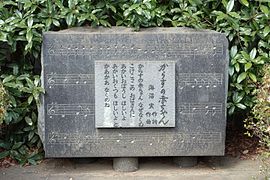Gokoku-ji
Gokoku-ji ( Japanese 護国寺 ) with the mountain name Shinreisan ( 神 鈴 山 ) and the sub-temple name Shitchi-in ( 悉 地 院 ) is a temple in Tokyo's Bunkyō district . It belongs to the Shingi ( 新 義 ) branch of the Shingon direction of Buddhism.
history
The Shogun Tokugawa Tsunayoshi had the temple built in 1681 at the request of the High Priest Ryōken ( 亮 賢 僧 正 ; 1611-1687), who adored his mother Keishō-in ( 桂 昌 院 ; 1627-1705) highly. Tsunayoshi made the Bakufu herb garden called Ōtsuka yakuen ( 大 塚 薬 園 ) available. - You can still see buildings in the style of the Genroku period, but in 1883 and 1926 most of the temple burned down. - Some old buildings were moved here after the last fire. During the Pacific War , the temple was spared from bombs. The planned access road, which was previously lined with shops on both sides, has also been preserved.
The attachment
You enter the temple through the "Niō Gate" ( 仁王 門 Niō-mon ), named after the two temple guards ( Niō ) to the right and left of the passage. Dan follows at the top of a staircase the "Middle Gate" ( 中 門 Chūmon ), here called "Gate of Immortality" ( 不 老 門 Furō-mon ), which was built in 1938. It is a copy of the main gate of the Kurama-dera in Kyoto. Another gate, the Sō-mon ( 惣 門 ), leads to the abortion residence. It has the shape of a gate, as was common in daimyo residences and was intended for high guests.
Behind the Furō-mon is a treasure pagoda ( 多 宝塔 Tahōtō ) on the left , a copy of the Ishiyama-dera's treasure pagoda , which was donated in 1938. Behind it follows the founder's hall ( 大師 堂 Daishi-dō ) from 1701. It is the Yakushi hall ( 薬 師 堂 Yakushi-dō ) of the temple, originally built elsewhere . The bell tower ( 鐘楼 Shōrō ) on the right side with a particularly high base has a temple bell ( 梵 鐘 Bonshō ) from 1682.
The main hall ( 本 堂 Hondō ) in advance dates from 1697 and is registered as an important cultural asset of Japan . Originally it was the Kannon Hall ( 観 音 堂 Kannon-dō ), which was moved here after the fire in 1928 when the old main hall was lost. And Kannon is also the main cult figure. The hall presents itself in a mixture of “ Japanese ” and Zen styles . It has a simple hipped roof and is covered with copper sheet.
To the left of the main hall is the "moonlight residence" ( 月光 殿 Gekkō-den ), which is also registered as an important cultural asset. It dates from the early Azuchi Momoyama period and is covered with left-aligned tiles. The building originally stood as a guest house on the grounds of Mii-dera in Shiga Prefecture , then moved to Tōkyō in 1888 and finally here in 1928.
The Yakushi Hall was originally the hall for storing a complete set of sutras. It dates from the Genroku period and is therefore an important cultural heritage.
Graves of famous people
The graves of famous personalities can be found in the temple's cemetery. These include the former Prime Minister Ōkuma Shigenobu , the military leader and politician Yamagata Aritomo , the politician Sanjō Sanetomi , the Japanese architect Josiah Conder , Okura Kihachirō ( 大 倉 喜 八郎 ; 1837-1828), entrepreneur, art collector and builder of the Ōkura Shūkokan .
photos
Others
The Gokoku-ji is also known as the temple for the practice of the tea ceremony .
Remarks
- ↑ 1873 was Emperor Meiji his first, stillborn son on a higher ground burial, which the gokoku-ji ceded the imperial family and therefore not part of the gokoku-ji. This part, called the Toshimagaoka Cemetery ( 豊 島 岡 霊 園 Toshimagaoka reien ), has been used as a cemetery by the imperial family ever since. This also includes families of the court nobility ( 公家 kuge ) such as Arisugawa-no-miya ( 有 栖 川 宮 ), Kitagawa-no-miya ( 北 川 宮 ), Chichibu-no-miya ( 秩 父 宮 ), Higashikuni-no-miya ( 東 久 邇 宮 ) , Takamatsu-no-miya ( 高 松 宮 ), Mikasa-no-miya ( 三 笠 宮 ) and Takamado-no-miya ( 高 窓 宮 ) are buried here. This cemetery is not open to the public.
- ↑ Umenuma Minoru ( 海 沼 實 ; 1909–1971), composer. Here is his song “The Crow Chick” ( か ら す の 赤 ち ゃ ん Karasu no akachan ).
Web links
- Gokoku-ji website (Japanese / English)
Coordinates: 35 ° 43 ′ 18.3 " N , 139 ° 43 ′ 32.4" E

